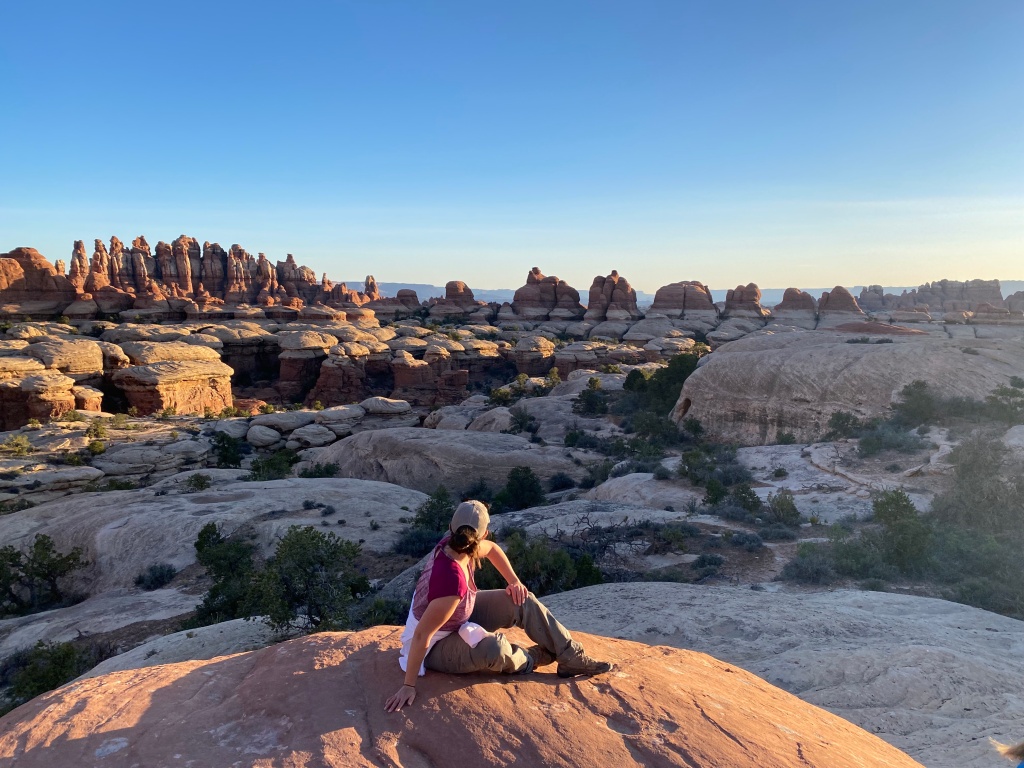Subscribe to the Newsletter
I’m rather embarrassed by this but I feel it’s important for others to learn from my mistakes. In mid-May, I hiked in the beautiful but very remote Needles District of Canyonlands National Park. Unfortunately, my backpacking trip ended with a helicopter ride out due to heatstroke.
I planned this trip for a year and dreamed about it for many more. We had packed in only about 2.5 miles the night before and spent a beautiful day hiking Chesler Park in the Canyonlands Needles District. Our giant loop took us around 12 miles with very little shade and no clouds. The temperatures that day were in the high 80s by the afternoon but much cooler in the morning. I didn’t know this then but according to a park ranger, the sand and rock can get 10 to 20 degrees hotter.

We returned to the campsite around 3 pm. While I felt hot on the trail, I didn’t feel sick and I had drank lots of water infused with Nuun tablets. Once back to my tent, I drank a lot more electrolyte water. Despite being done and as the day wore on, I felt worse and worse. I had a headache, nausea, and dizziness. I still wasn’t too worried as I figured once the sun went down, I’d bounce back.
Unfortunately, I only worsened until about 7 pm when I started to throw up. I got clammy and shaky and my stomach tightened, making it impossible to drink or stand. That’s when I got scared. I have an InReach GPS and I set off the SOS rescue signal. Luckily, I was with three women with level heads who kept watch on me. It took a few hours for the first ranger to reach us. I tried to walk out to meet him (I mistakenly thought they would bring a stretcher and wanted to save time), but immediately grew dizzy and had to return to the tent.

Not long after the ranger arrived, I started to finally rebound and the tightness and shaking abated. An EMT gave me an anti-nausea pill, which helped a lot. A helicopter was already en route as Canyonlands takes heatstroke seriously, having lost a visitor last year to it. The man sadly made a lot of mistakes, including hiking in 100-degree temps with no ability to message for help.
I was given the choice to stay put for the night, get a ride to the trailhead, or be taken to the hospital in Moab. By that time, I was feeling a little better but was scared about staying the night and walking out the next morning. (I collapsed once due to heatstroke years ago.) I asked to go to the trailhead.
Once there, I was able to sleep in my car where we had a cooler full of Gatorades and water. By the next morning, I felt a lot better but was still dizzy and nauseous and relieved I didn’t have to hike out. My companions hiked out under the moonlight and met me at the trailhead.
What I Did Wrong
- I should’ve started earlier. While we were on the trail by 6 am, I didn’t understand how much hotter 85 degrees would be in the desert.
- I should’ve drank a lot more electrolyte water the previous day. While I drank lots on the trail, it wasn’t enough.
- Beyond my electrolyte water, I didn’t have anything else to alleviate my heat. I took a salt pill but not until after I got sick. I should’ve planned better.
- I changed the plan. I originally intended one loop where I would drop out early if necessary (there’s a trail that cuts the loop in half). A ranger recommended we go a different route, which meant I couldn’t drop out early. I should’ve known my limitations and not changed the plan.
- I actually gave blood the Tuesday before and I’m not sure if that weakened me.

What I Did Right
- I have my InReach GPS anytime I go into the backcountry and have for years. This was the first time I had to use it.
- I got out instead of pushing through due to misplaced pride. The ranger said that it’s really hard for the body to rebound on the trail and it’s better to get out. I think if I’d ended the hike at my car versus the backcountry, I would’ve been fine. I just couldn’t control my temps still out in the desert.
- I trained a lot for this hike, including taking my pack and practicing with weight on steep inclines. I’m still surprised I went down so hard.
I’m grateful to my companions for their aid and patience. I’m grateful to the rangers, EMTs, and pilots for their skills. I’ll never forget the helicopter buzzing the red rock canyons in the moonlight and wished I could’ve sat up and enjoyed it more. I’m grateful to enjoy the backcountry and will return but more prepared and humbled.
For an outdoor adventure without ever having to get outside, check out the Lost Gorge Mystery series!

Follow on Pinterest here!


I am so glad that you are ok, but I can imagine this was scary and frustrating. I really appreciate you sharing your experience and what you learned.
LikeLike
Hiking in the desert is no joke!
I’m glad that you had your InReach with you and they were able to get a ride back to the trailhead to rest up.
This is why many trails are now closing in Phoenix when temps go over 105 degrees. Frankly, they should close when temps are above 90.
Heat stroke happens ALL THE TIME even in much milder conditions. This is a great article, I’m sorry you had to go through it, but its a good warning for others.
LikeLike